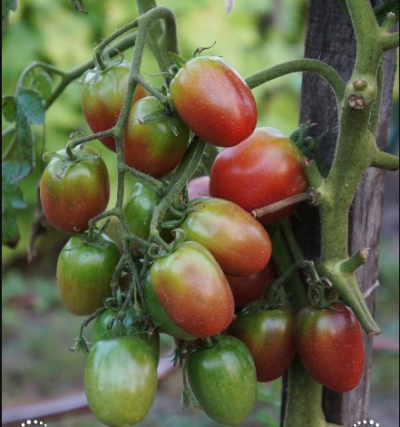
- Authors: Dederko V.N., Postnikova O.V.
- Category: grade
- Growth type: indeterminate
- Appointment: fresh consumption, for pickling and preserving
- Ripening period: mid-season
- Ripening time, days: 95-105
- Growing conditions: for film greenhouses
- Marketability: high
- Bush size: tall
- Bush height, cm: up to 200
Kazachka is a popular variety of tomatoes, bred by Russian breeders Dederko V.N. and Postnikova O. V. Kazachka can be grown both on an industrial scale and in a private summer cottage. The taste qualities of the fruits are highly appreciated by consumers, but not everyone can manage the agricultural technology of the variety.
Description of the variety
The bush of the Kazachka variety is tall, reaches a height of 200 cm, the leaves are large, dark green in color.
The main qualities of the fruit
The unripe fruit is green in color with a dark spot at the stalk; when ripe, its skin has a dark crimson color. Tomatoes are small in size, weighing only 35-50 g, round in shape.
Taste characteristics
The pulp of Kazachka tomatoes is juicy, sugar, sweet. The thin skin is hardly noticeable when eaten fresh. The flavor is best revealed when tomatoes are added to a fresh salad. A large amount of vitamin moisture allows you to use tomatoes for juicing. You can use the fruits for canning and pickling, but this is not very convenient due to the thin skin.
Keep in mind that Kazachka fruits have good keeping quality, excellent presentation and ripening ability, however, ripening not on a branch negatively affects the taste characteristics of tomatoes, therefore it is recommended to use them in a ripe state immediately after removal from the bush.
Ripening and fruiting
This variety belongs to the varieties with a mid-season ripening period, you can harvest in 95-105 days after the first shoots appear.
Yield
One bush gives 2-2.5 kg of yield or 8-10 kg per 1 m2. Judging by these data and the fact that the weight of the fruits is very small, it can be assumed that the bush bears fruit throughout the entire growing season.
The timing of planting seedlings and planting in the ground
Sowing is carried out 60-65 days before transplanting to a summer cottage. The seed germination of the presented variety is excellent, but for the prevention of diseases, it is recommended to process the planting material in a solution of potassium permanganate for 20 minutes. The same processing is required for the substrate where the seeds will be planted.
The grains are deepened by 1.5 cm, then ordinary earth is scattered and the soil is sprayed with water. Before the first shoots hatch, the container is removed under a film and placed in a warm, dark place. The shelter can be removed when the first shoots appear. Further, it is important to moisten the soil, maintain the temperature + 18 ... 20 degrees, and provide the sprouts with good illumination.
When 2-3 leaves appear, the bushes dive. Young shoots need watering every 5 days, and a week before transplanting them to the site, they need to start hardening.

Growing tomato seedlings is an extremely important process, because it largely depends on whether the gardener will be able to harvest at all. All aspects must be taken into account, from seedbed preparation to planting in the ground.
Landing scheme
When transplanting, the plants are arranged according to the 50x50cm scheme, that is, 4 bushes are planted per 1 m2. The culture is ready for transplanting when the height of the shoots reaches 27 cm. It is recommended to treat the root with Fitosporin before planting to protect the seedlings from fungus.

Growing and care
The presented variety is grown in film greenhouses. The plant requires a garter to support and the formation of 1-2 stems. And also you need to remember about the pinning of culture.
Don't forget to water regularly, too. The bushes are irrigated with warm water, it is better to use drip irrigation. After moistening, the soil must be loosened. Avoid overfilling as this can lead to fungal infections and pollen adhesion.
The plant needs fertilization three times per season: two weeks after transplanting into the greenhouse, one month after the first feeding, and one more month later.




A plant needs different micronutrients at each stage of growth. All fertilizers can be divided into two groups: mineral and organic. Folk remedies are often used: iodine, yeast, bird droppings, eggshells.
It is important to observe the rate and period of feeding. This also applies to folk remedies and organic fertilizers.
Disease and pest resistance
Cossack bushes cannot boast of good immunity to diseases. The culture can be affected by late blight or Alternaria. As a preventive measure, disinfect the soil at the planting stage, plant green manure, treat the bushes with Fitosporin during the entire growing season.
Of the pests, the plant most often becomes a victim of whitefly, aphids, Colorado potato beetle, spider mite. Insects can be collected mechanically and destroyed, as well as using infusions of garlic, onion husks, tobacco dust. If the case is neglected, then you need to use serious drugs, such as "Fufanon", "Aktara", "Prestige".



























































































